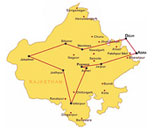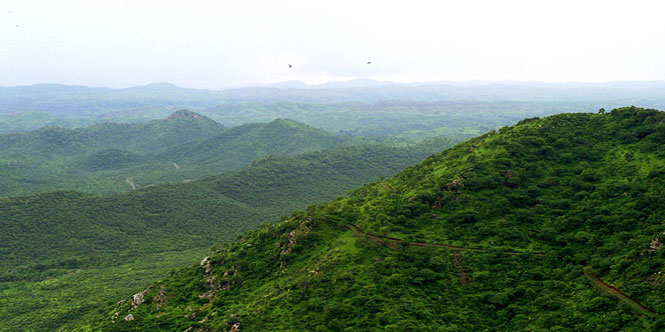About Rajasthan
History of Rajasthan
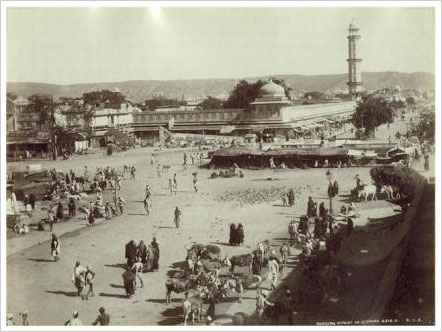
Geography of Rajasthan
Rajasthan, situated at the northwestern part of India is the biggest state in the country of India and lies between 2330 and 30 11 North latitude and 69 29 and 78 17 East longitude. The state shares its north-western and western boundary with the Indo-Pakistan international border that extends about 1,070 km and touches the major districts Barmer, Bikaner, Ganganagar and Jaisalmer.
Rajasthan is bordered by Pakistan in the west and northwest, the states of Punjab, Uttar Pradesh and Haryana in the north and northeast. The state of Madhya Pradesh lies in the southeast and Gujrat in the southwest.
The huge portion of the state of Rajasthan is desiccated and houses the biggest Indian desert- the Thar Desert known as the 'Maru-kantar'. The oldest chain of fold mountains- the Aravalli Range splits the state into two geographical zones- desert at one side and forest belt on the other. Only 9.36% of the total geographical region lies under forest vegetation.
The Aravalli Range literally meaning 'line of peaks', is a range of mountains in western India running approximately 800 km from northeast to southwest across states of Rajasthan, Haryana, and Gujarat.
The Thar Desert of Rajasthan is situated partlyin India and partly in Pakistan. Bordering the desert on four sides are, Indus plains to the west, Aravalli Range to the southeast, Rann of Kutch to the south, and Punjab plains to the north and northeast.
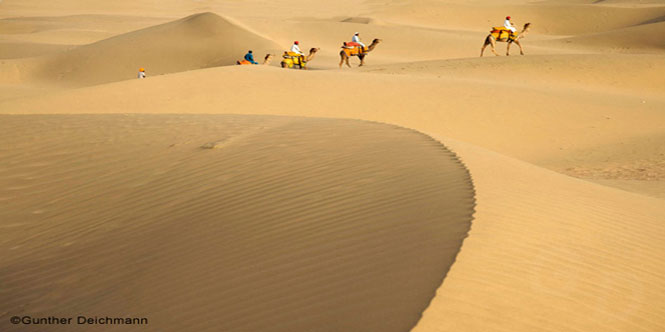
Weather in Rajasthan
Varies with the seasons of the year. The weather in Rajasthan ranges from very hot in summer to chilly in winter.
- Summer - April to June
- Monsoon - Late June to September
- Post-Monsoon - October to November
- Winter - December to March
Flora and Fauna
The extreme climatic conditions of Rajasthan make the state experience scorchingheat during the summers and chilling cold during the winters. Those who wish to visit Rajasthan are advised to avoid the summer months, as the temperature during this time ranges between 32C and 45C. During the winter months, the temperature falls below 0C. Tourists prefer to come to Rajasthan between July and September. During this period, the weather condition of the state remains quite pleasant and suitable for tourism.
The Rajasthan state has a lot to offer in terms of flora and fauna. The state possesses about 32549.64 square kilometers of forest area spread across northern, eastern, south-eastern and southern parts of the territory. Being a rich reserve of wildlife, Rajasthan is known for panther, blue bull, jackal, fox, hyena, sambhar, wild boar, jungle cat and many other species of animals.
Location of Rajasthan
Rajasthan is located in the northwestern part of India and is bounded by Punjab, Haryana and Uttar Pradesh. With its rich cultural heritage, sand dunes, safaris and wildlife, the state has a lot to offer in terms of tourism. Rajasthan seems to be an open museum, where the tourists can get a glimpse of the socio-cultural pattern of the state.
The state of Rajasthan is well connected with an excellent network of transportation to the different parts of the country. Jaipur, Udaipur and Jodhpur are the three main airports in Rajasthan, which are regularly operated by domestic and international flights. Some of the major railway stations in Rajasthan are at Jodhpur, Udaipur, Ajmer and Jaipur. Besides, the state is also known to possess a well-knit network of roads. The National Highways and State Highways connect the different towns and cities of Rajasthan within the different parts of the country.
Tourists can get a glimpse of the Mughal architecture at different forts and palaces situated at various parts of Rajasthan. Rajasthan also possesses a number of other appeals that attract tourists from all corners of the world.
Districts in Rajasthan
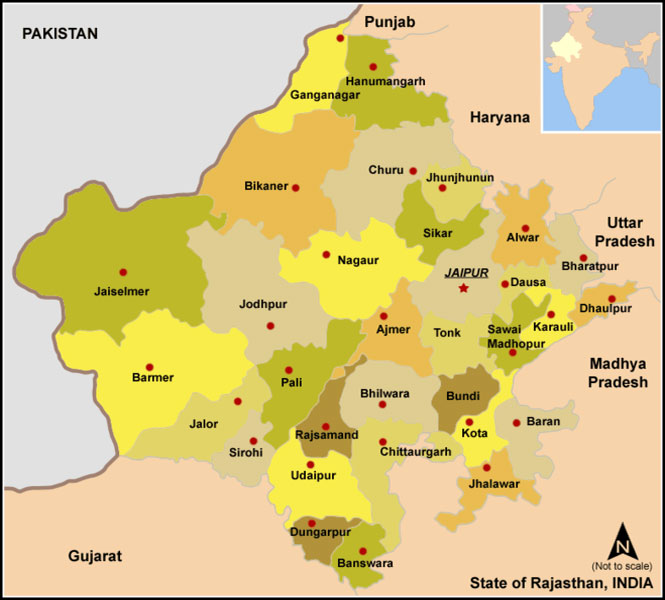
Ajmer Division : Ajmer, Bhilwara, Nagaur, Tonk
Bharatpur Division : Bharatpur, Dholpur, Karauli, Sawai Madhopur
Bikaner Division : Bikaner, Churu, Ganganagar, Hanumangarh
Jaipur Division : Jaipur, Alwar, Jhunjhunu, Sikar, Dausa
Jodhpur Division : Barmer, Jaisalmer, Jalore, Jodhpur District, Pali, Sirohi
Kota Division : Baran, Bundi, Jhalawar, Kota
Udaipur Division : Banswara District, Chittorgarh District, Pratapgarh District, Dungarpur District, Udaipur, Rajsamand
Fact File of Rajasthan
Population : 64.07 million (2006-07)
Area : 3,42,239 sq km
Location : North-western India; shares domestic borders with Punjab, Haryana, Uttar Pradesh, Madhya Pradesh and Gujarat.
Population Density : 165 (per sq km), Population Growth: 28.4%
Principal Languages : Rajasthani & Hindi
Capital : Jaipur
Time Zone : GMT + 5 hours, 30 minutes
Currency : Indian Rupee (Rs)
Districts : 33
Urban Population : 23.38%
Cities and Towns : 222
Religion : Hindu 89%, Muslim 7%, Jain 1.8%, Sikh 1.5%, Christian 0.1%.
Best Time To Visit : November-March
Climate : Generally dry with extreme temperatures; and rains during July-August
Major Cities : Jaipur, Jodhpur, Udaipur, Kota, Ajmer, Bikaner, Bhilwara, Alwar
Major Crops : Jowar, bajra, wheat, maize, pulses, barley, gram, oilseeds, cotton, tobacco, sugarcane.
Minerals : Gypsum, mica, copper, tungsten, emerald, asbestos, felspar, glass-sand gypsum, iron ore, lead, zinc, limestone, marble, salt, silver, soapstone & marble.
Industries : Textiles, cement, sugar, chemicals, glass, wool, handicrafts.
Roads : 83,469 km
Railways : 6,228 km

